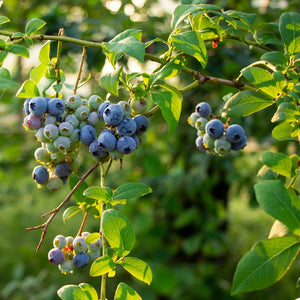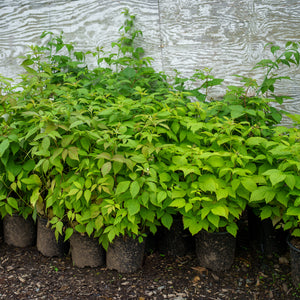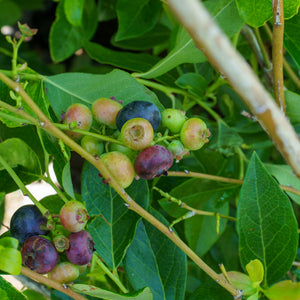The Fruit Bush Guide
Fruit bushes bring beauty, biodiversity, and bounty to gardens of all sizes. Whether you're planting blueberries, raspberries, blackberries, strawberries, or huckleberries, these compact producers offer edible rewards with ornamental value. Ideal for home gardeners, edible landscapes, and container growers alike, fruit bushes are accessible, productive, and deeply satisfying to grow.

About
Fruit bushes include a variety of species from different plant families, all sharing a bushy or semi-upright growth habit and the ability to produce fruit with minimal space. Some, like blueberries (Vaccinium corymbosum), are native to North America and thrive in acidic soils, while others, like raspberries and blackberries (Rubus spp.), are vigorous cane-forming shrubs that yield prolific harvests with the right pruning and support.
Among the most common fruit bushes are:
- Blueberries (Vaccinium corymbosum): 'Bluecrop', 'Duke', and 'Patriot' are popular highbush cultivars, known for reliable harvests and cold hardiness.
- Raspberries (Rubus idaeus): Varieties like 'Heritage', 'Coho', 'Meeker', 'Caroline', and golden-fruited 'Fall Gold' offer summer and fall harvests.
- Blackberries (Rubus spp.): Varieties like 'Bristol' and 'Willamette' produce large, juicy fruit and spread by arching canes.
- Strawberries (Fragaria spp.): Compact, everbearing types like 'Gasana', 'Tristan', and ornamental 'Lipstick' and 'Variegata' make great edible borders.
- Huckleberries (Gaylussacia baccata): A native North American shrub with dark blue, sweet berries that support pollinators and wildlife.
Fruit bushes offer long-term yields and can be mixed into ornamental plantings, borders, or dedicated food gardens.
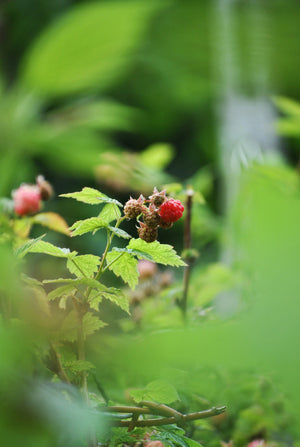
PLANTING
Successful fruit production starts with good site preparation, correct spacing, and thoughtful cultivar selection:
- USDA Hardiness Zones: Most fruit bushes thrive in Zones 4–8, though some strawberry and blackberry varieties may extend beyond.
- Soil: Blueberries require acidic soil (pH 4.5–5.5), while raspberries, blackberries, and strawberries do best in slightly acidic to neutral, well-drained loam.
- Sunlight: Full sun (6–8 hours daily) is essential for fruiting.
- Watering: Water regularly, especially during establishment and fruit development. Keep soil consistently moist but not soggy.
- Blueberry Spacing: 3–5 feet apart.
- Raspberry/Blackberry Spacing: 2–3 feet apart in rows with 6–8 feet between rows.
- Strawberry Spacing: 12–18 inches apart.
- Planting Time: Early spring or fall is best. Avoid planting in frozen or overly wet soil.
Prepare soil with compost or aged manure. For blueberries, incorporate peat moss or sulfur to adjust pH.

CARE
While fruit bushes vary in maintenance, most respond well to basic care practices that encourage strong yields:
- Blueberry Pruning: Prune in late winter to remove old or weak canes and improve air circulation.
- Raspberry/Blackberry Pruning: Prune annually depending on variety (summer-bearing vs. everbearing).
- Strawberry Pruning: Remove runners if you want larger berries; let them spread if creating a groundcover.
- Blueberry Fertilizing: Use acidic plant fertilizer (azalea or rhododendron formulas).
- Rubus and Fragaria Fertilizing: Apply balanced fertilizer in early spring and again after harvest.
- Mulching: Apply mulch to retain moisture, suppress weeds, and regulate temperature.
- Pest & Disease Management: Keep areas well-weeded and clean. Watch for birds, Japanese beetles, powdery mildew, and cane borers.
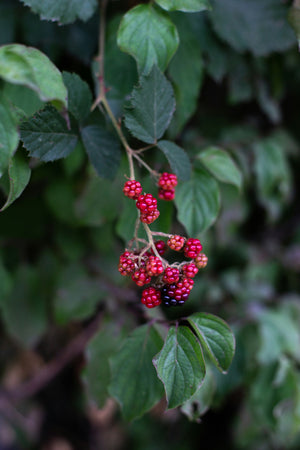
HOW TO USE
Fruit bushes offer both culinary and ornamental value. Integrate them into your landscape for aesthetics and productivity:
- Edible Landscaping: Use blueberries and strawberries in garden borders or as foundation plants.
- Pollinator Gardens: Raspberries, blackberries, and huckleberries attract bees and beneficial insects.
- Containers: Strawberries and compact blueberries can thrive in pots with proper drainage and acidic soil.
- Fruit Hedges: Use raspberries or blackberries as informal, fruiting hedgerows.
- Family Gardens: Great for teaching kids about gardening and providing a regular harvest of fresh snacks.
Pair fruit bushes with herbaceous companions like mint, chives, or thyme to repel pests, or with flowers like echinacea and rudbeckia for color and biodiversity.
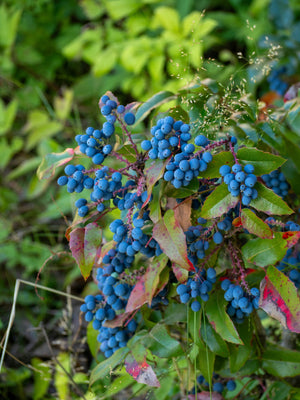
COMMON QUESTIONS
- What fruits grow on bushes? Common bush fruits include blueberries, raspberries, blackberries, strawberries, gooseberries, currants, and huckleberries.
- Do you need two blueberry bushes to get fruit? While many blueberries are self-fertile, planting two or more different varieties improves yield and fruit size.
- How long does it take blueberry bushes to produce fruit? Expect a modest crop in the second year, with full production starting in year 3–4.
- When do raspberry bushes produce fruit? Summer-bearing varieties fruit in early summer; everbearing types fruit in summer and again in early fall.
- When do blackberry bushes produce fruit? Blackberries typically ripen from mid to late summer depending on variety and region.
- Do you need two blackberry bushes to produce fruit? Most blackberry cultivars are self-fertile and do not require cross-pollination.
- Do you need two raspberry bushes to produce fruit? Like blackberries, most raspberry varieties are self-fertile and productive as solo plants.
Conclusion
Fruit bushes combine form, function, and flavor in any garden setting. Whether you're cultivating a backyard food forest, a few containers on a patio, or an ornamental landscape with edible accents, these hardy shrubs reward with years of delicious harvests. With a little planning and care, you can enjoy fresh berries right outside your door—beautiful, nutritious, and homegrown.
The Fruit Bush Collection
Sold Out
Sold Out
Sold Out
Sold Out
Sold Out



